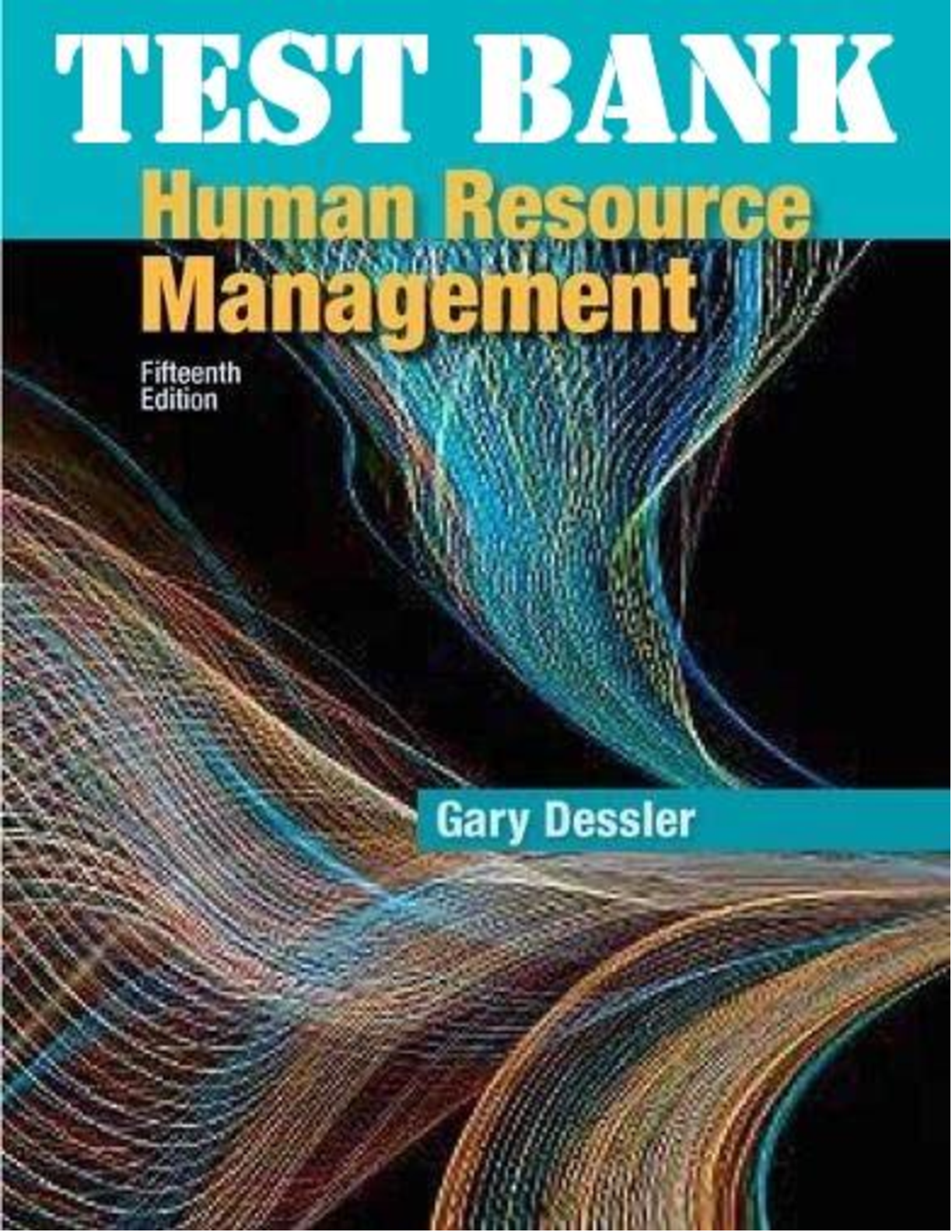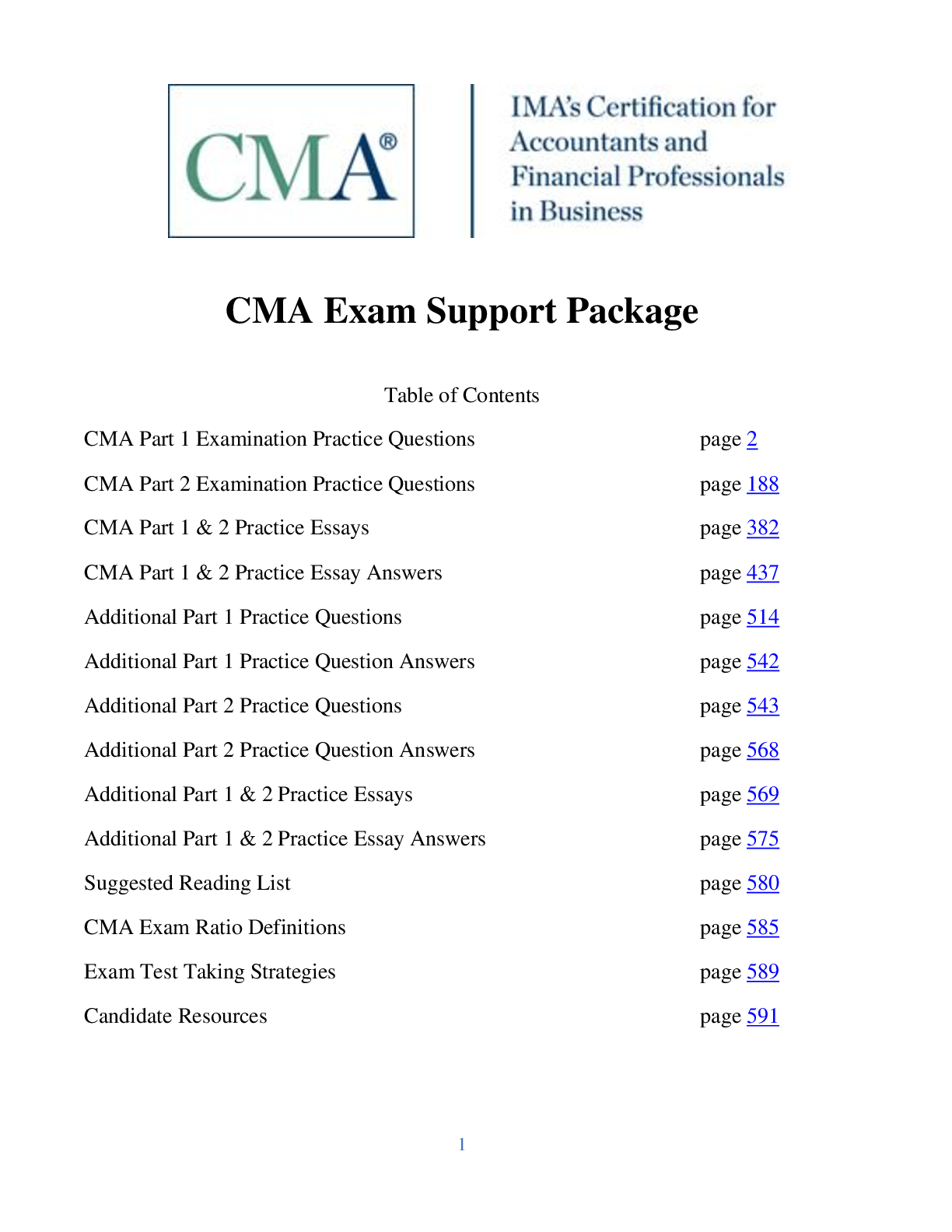Financial Accounting > TEST BANKS > Certified Management Accountant (CMA), CMA 4 ALL SE, Wiley Efficient Learning, / Wiley CMA Excel Exa (All)
Certified Management Accountant (CMA), CMA 4 ALL SE, Wiley Efficient Learning, / Wiley CMA Excel Exam Review 2021 Flashcards. 3136 MCQ+ Rationale. 526 Pages. TEST BANK & FLASHCARDS
Document Content and Description Below
CMA 4 ALL SE 1.A.1.b tb.fin.inc.010_1805 LOS: 1.A.1.b Lesson Reference: Overview of Financial Statements and the Income Statement Difficulty: hard Bloom Code: 4 The most likely use of an income... statement prepared by a business enterprise is its use by which of the following? Labor unions to examine earnings closely as a basis for salary discussions. Government agencies to formulate tax and economic policy. Customers to determine a company's ability to provide needed goods and services. Investors interested in the financial performance of the entity. Rationale Investors interested in the financial performance of the entity. The FASB's conceptual framework identifies potential investors and creditors as the primary focus of financial statements. An income statement provides information about a business's profitability. Whether a business is profitable is likely to influence an investor's decision to invest in that business as it is one aspect of its financial performance. Therefore, this is the correct answer. Rationale Labor unions to examine earnings closely as a basis for salary discussions. While labor unions may examine earnings as a basis for salary discussions, it is just one factor in those discussions. In addition, the FASB conceptual framework identifies potential investors and creditors, not labor unions, as the primary focus of financial statements. Therefore, this is an incorrect answer. Rationale Government agencies to formulate tax and economic policy. An income statement provides information about one business and is not likely to be very useful to formulate tax and economic policy. It is based on accrual accounting, which is different from tax accounting. Therefore, this is an incorrect answer. Rationale Customers to determine a company's ability to provide needed goods and services. A customer may use an income statement to assess a company's financial performance as a company in poor financial condition may not be reliable supplier. However, it is not likely to be the major factor in the decision. Therefore, this is an incorrect answer. Correct Question 2 1.A.1.a tb.fin.inc.001_1805 LOS: 1.A.1.a Lesson Reference: Overview of Financial Statements and the Income Statement Difficulty: medium Bloom Code: 4 Which aspect of a firm's statement of cash flows most interests potential stockholders? Changes in the firm's inventory balance The firm's gains and losses from selling plant assets The firm's investments in new plant assets Rationale The firm's investments in new plant assets Potential shareholders are generally most interested in a firm's ability to increase its stock price and pay dividends. While investment in new plant assets may give some information about a firm's growth potential, it does not provide the most useful information to potential shareholders because it does not involve dividends. Therefore, this is an incorrect answer. Rationale Changes in the firm's inventory balance A change in a firm's inventory balance is important information. However, potential shareholders are more interested in cash flow generated. Additionally, the change in inventory is better seen by looking at the balance sheet. Therefore, this is an incorrect answer. Rationale The firm's gains and losses from selling plant assets Gains and losses from selling plant assets is important information. However, potential shareholders are more interested in cash flow generated. Therefore, this is an incorrect answer. Rationale The firm's ability to pay dividends Potential shareholders are generally interested in a firm's ability to increase its stock price and pay dividends. The statement of cash flows provides information about cash generated (that can be used for future dividends) and cash used to pay dividends in the past. Therefore, this is the correct answer. The firm's ability to pay dividends Correct Your Answer Question 3 1.A.1.e tb.fin.inc.018_1805 LOS: 1.A.1.e Lesson Reference: Overview of Financial Statements and the Income Statement Difficulty: medium Bloom Code: 4 When using the indirect method, which statement provides the most accurate description of the relationship between accounts receivable and the operating activities section on the statement of cash flows? A decrease in accounts receivable results in a decrease in the operating activities section on the statement of cash flows. A decrease in accounts receivable results in no change in the operating activities section on the statement of cash flows. An increase in accounts receivable results in a decrease in the operating activities section on the statement of cash flows. Rationale An increase in accounts receivable results in an increase in the operating activities section on the statement of cash flows. An increase in accounts receivable means that sales made on credit exceeded collections from customers. Since net income (the starting point of the operating activities section) uses cash sales and not cash collections, adding the increase in accounts receivable would result in “double counting” cash collections. Therefore, this is an incorrect answer. Rationale An increase in accounts receivable results in a decrease in the operating activities section on the statement of cash flows. An increase in accounts receivable means that sales made on credit exceeded collections from customers. Since net income (the starting point of the operating activities section) uses cash sales and not cash collections, the increase in accounts receivable must be subtracted when calculating cash flow from operating activities. Therefore, this is the correct answer. Rationale A decrease in accounts receivable results in a decrease in the operating activities section on the statement of cash flows. A decrease in accounts receivable means that collections from customers exceeded sales made on credit. Since net income (the starting point of the operating activities section) uses cash sales and not cash collections, the decrease in accounts receivable must be added when calculating cash flow from operating activities, not subtracted. Otherwise, cash flow from operating activities would be understated. Therefore, this is an incorrect answer. Rationale A decrease in accounts receivable results in no change in the operating activities section on the statement of cash flows. A decrease in accounts receivable means that collections from customers exceeded sales made on credit. Since net income (the starting point of the operating activities section) uses cash sales and not cash collections, the decrease in accounts receivable must be added when calculating cash flow from operating activities. Otherwise, cash flow from operating activities would be understated. Therefore, this is an incorrect answer. Correct An increase in accounts receivable results in an increase in the operating activities section on the statement of cash flows. Your Answer https://t.me/joinchat/AAAAAEmdkQm8l_10mjxMXQ Question 4 1.A.2.dd tb.fin.inc.042_1805 LOS: 1.A.2.dd Lesson Reference: Overview of Financial Statements and the Income Statement Difficulty: medium Bloom Code: 4 According to the FASB's conceptual framework, which of the following is/are included in comprehensive income? Neither gross margin nor operating income Gross margin Operating income Gross margin and operating income Rationale Neither gross margin nor operating income Comprehensive income includes all changes in equity during a period except changes from investments by owners and distributions to owners. Net income is the starting point for calculating it. Since operating income and gross margin are both components of net income, they are also components of comprehensive income. Therefore, this is an incorrect answer. Rationale Gross margin and operating income Comprehensive income includes all changes in equity during a period except changes from investments by owners and distributions to owners. Net income is the starting point for calculating it. Since operating income and gross margin are both components of net income, they are also components of comprehensive income. Therefore, this is the correct answer. Rationale Gross margin Comprehensive income includes all changes in equity during a period except changes from investments by owners and distributions to owners. Net income is the starting point for calculating it. Since gross margin is a component of net income, it is also a component of comprehensive income. However, operating income is also a component. Therefore, this is an incorrect answer. Rationale Operating income Comprehensive income includes all changes in equity during a period except changes from investments by owners and distributions to owners. Net income is the starting point for calculating it. Since operating income is a component of net income, it is also a component of comprehensive income. However, gross margin is also a component. Therefore, this is an incorrect answer. Correct Question 5 1.A.2.dd fin.inc.tb.048_0120 LOS: 1.A.2.dd Lesson Reference: Overview of Financial Statements and the Income Statement Difficulty: medium Bloom Code: 3 A company is preparing its financial statements in accordance with U.S. GAAP. Listed below are select financial data for the company. Net income = $950,000 Depreciation = $40,000 Investment by owners = $60,000 Unrealized gain on available-for-sale securities = $90,000 Foreign currency translation loss = $20,000 What is the amount that would be reported as comprehensive income? *Source: Retired ICMA CMA Exam Questions. $970,000 $1,060,000 $1,120,000 $1,020,000 Rationale $970,000 This answer is incorrect. Depreciation is not added back to net income when calculating comprehensive income since comprehensive income is not based on cash flow. In addition, owner investment is not included in comprehensive income since comprehensive income does not focus on transactions with owners. Finally, unrealized gains on available-for-sale securities and foreign currency translation losses should be included when calculating comprehensive income. Rationale $1,020,000 The calculation of comprehensive income starts with net income and includes unrealized gains and losses on available-for-sale securities, cash flow hedges gains and losses, foreign currency translation gains and losses, and gains and losses in pension and post-retirement benefit plans. In this example, comprehensive income includes the net income of $950,000, the unrealized gain on available-for-sale securities of $90,000, and the foreign currency translation loss of $20,000 ($950,000 + $90,000 - $20,000). This results in comprehensive income of $1,020,000. Rationale $1,060,000 This answer is incorrect. Depreciation is not added back to net income when calculating comprehensive income since comprehensive income is not based on cash flow. Rationale $1,120,000 This answer is incorrect. Depreciation is not added back to net income when calculating comprehensive income since comprehensive income is not based on cash flow. In addition, owner investment is not included in comprehensive income since comprehensive income does not focus on transactions with owners. Correct Question 6 1.A.1.b tb.fin.inc.007_1805 LOS: 1.A.1.b Lesson Reference: Overview of Financial Statements and the Income Statement Difficulty: medium Bloom Code: 4 Your boss at Trinitron Inc. wants to discuss the origin of the company's cash in the last year and how it was used. What documents should you bring to the meeting? The comparative balance sheet and the retained earnings statement The income statements from last year and the year before Rationale The comparative balance sheet and the retained earnings statement The comparative balance sheet provides information on how the company's cash balance changed from one period to the next, but it will not provide information about why the cash balance changed. The retained earnings statement will provide information about the amount of dividends declared, but it will not provide information about the amount of dividends paid or information about any other use or source of cash. Therefore, this is an incorrect answer. Rationale The income statements from last year and the year before The income statement provides information about revenues and expenses, but not about the amount of cash generated or used in various activities. Therefore, this is an incorrect answer. Rationale The statement of cash flows and supplementary schedules The statement of cash flows provides information about the amount of cash generated by and used in operating, investing, and financing activities for a given period of time. Supplementary schedules provide information on how much cash was used for interest and tax payments, as well as information on significant non-cash activities. Therefore, this is the correct answer. Rationale The balance sheet and the income statement The balance sheet provides the cash balance as of a particular date, but it does not provide information about the sources or uses of cash for a given period of time. The income statement provides information about revenues and expenses, but not about the amount of cash generated or used in various activities. Therefore, this is an incorrect answer. The statement of cash flows and supplementary schedules Correct The balance sheet and the income statement Your Answer Question 7 1.A.2.cc tb.fin.inc.036_1805 LOS: 1.A.2.cc Lesson Reference: Overview of Financial Statements and the Income Statement Difficulty: medium Bloom Code: 4 A justification for the periodic recording of depreciation expense can be demonstrated by which of the following? The association of efforts (expense) with accomplishments (revenue) Immediate recognition of an expense Rationale The association of efforts (expense) with accomplishments (revenue) Fixed assets are subject to depreciation expense. It is necessary to record depreciation expense because fixed assets provide benefits over multiple periods. In general expenses are recorded based on the matching principle in order to match accomplishments (revenue) with efforts (expenses). However, it is not always possible to do this with fixed assets. Therefore, this is an incorrect answer. Rationale Immediate recognition of an expense Fixed assets are subject to depreciation expense. It is necessary to record depreciation expense because fixed assets provide benefits over multiple periods. The expense is not immediately recognized. Therefore, this is an incorrect answer. Rationale Minimization of income tax liability Fixed assets are subject to depreciation expense. It is necessary to record depreciation expense because fixed assets provide benefits over multiple periods. Immediately expensing fixed assets would minimize income taxes by a greater amount than recording depreciation expense over multiple periods. Additionally, minimizing taxes is not a factor in financial accounting decisions. Therefore, this is an incorrect answer. Rationale Systematic and rational allocation of cost over the periods benefited Fixed assets are subject to depreciation expense. It is necessary to record depreciation expense because fixed assets provide benefits over multiple periods. Because it is not always possible to match accomplishments (revenue) with efforts (expense) concerning fixed assets, depreciation expense must be calculated in a systematic and rational manner. Therefore, this is the correct answer. Systematic and rational allocation of cost over the periods benefited Correct Minimization of income tax liability Your Answer Question 8 1.A.1.f 2B3-AT10 LOS: 1.A.1.f Lesson Reference: Overview of Financial Statements and the Income Statement Difficulty: easy Bloom Code: 2 The contents of the section of the annual report entitled “Management’s Discussion and Analysis” (MD&A) are: not reviewed by independent auditors. not mandated. mandated by pronouncements of the Financial Accounting Standards Board. Rationale not reviewed by independent auditors. This answer is incorrect. The MD&A is reviewed by independent auditors. Rationale mandated by regulations of the Securities and Exchange Commission (SEC). The SEC requires that all publicly held corporations include an MD&A in their annual financial report. The SEC mandates coverage of liquidity, risk, and sustainability of earnings in the MD&A. Rationale mandated by pronouncements of the Financial Accounting Standards Board. This answer is incorrect. The MD&A is not mandated by pronouncements of the Financial Accounting Standards Board. Rationale not mandated. This answer is incorrect. The MD&A is mandated. mandated by regulations of the Securities and Exchange Commission (SEC). Correct Your Answer Question 9 1.A.1.a tb.fin.inc.003_1805 LOS: 1.A.1.a Lesson Reference: Overview of Financial Statements and the Income Statement Difficulty: medium Bloom Code: 4 How are financial statements related to the objective of financial reporting? Companies use financial statements to document their cash flow, and documenting cash flow is the objective of financial reporting. Companies use financial statements to determine which new projects to pursue, and deciding which projects to pursue is the objective of financial reporting. Rationale Companies use financial statements to document their cash flow, and documenting cash flow is the objective of financial reporting. Documenting cash flow is important, but it is not the only objective of financial reporting. In addition, only one financial statement directly relates to cash flow. Therefore, this is an incorrect answer. Rationale Companies use financial statements to determine selling prices of products, and determining selling prices of products is the objective of financial reporting. Determining selling prices is not an objective of financial reporting. It is one goal of managerial accounting. Therefore, this is an incorrect answer. Rationale Companies use financial statements to determine which new projects to pursue, and deciding which projects to pursue is the objective of financial reporting. Determining which new projects to pursue is not an objective of financial reporting. It is related to managerial accounting. Therefore, this is an incorrect answer. Rationale Companies use financial statements to provide financial information to potential capital providers, and providing information to capital providers is the objective of financial reporting. The main objective of financial reporting is to provide information to capital providers (investors and creditors). Financial statements are one way that information is provided to capital providers. Therefore, this is the correct answer. [Show More]
Last updated: 2 years ago
Preview 1 out of 526 pages

Buy this document to get the full access instantly
Instant Download Access after purchase
Buy NowInstant download
We Accept:

Reviews( 0 )
$19.50
Can't find what you want? Try our AI powered Search
Document information
Connected school, study & course
About the document
Uploaded On
Jun 11, 2022
Number of pages
526
Written in
Additional information
This document has been written for:
Uploaded
Jun 11, 2022
Downloads
1
Views
270













, CMA 4 ALL SE, Wiley Efficient Learning, Wiley CMA Excel 2021.png)


